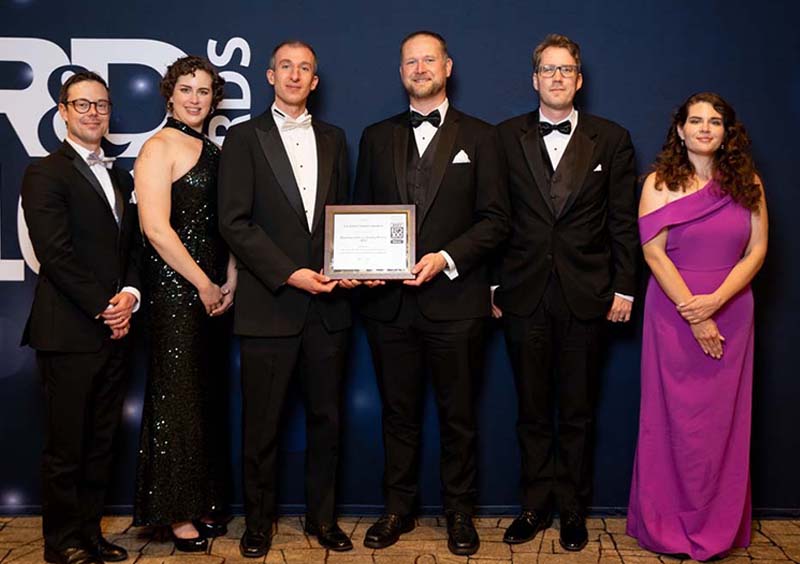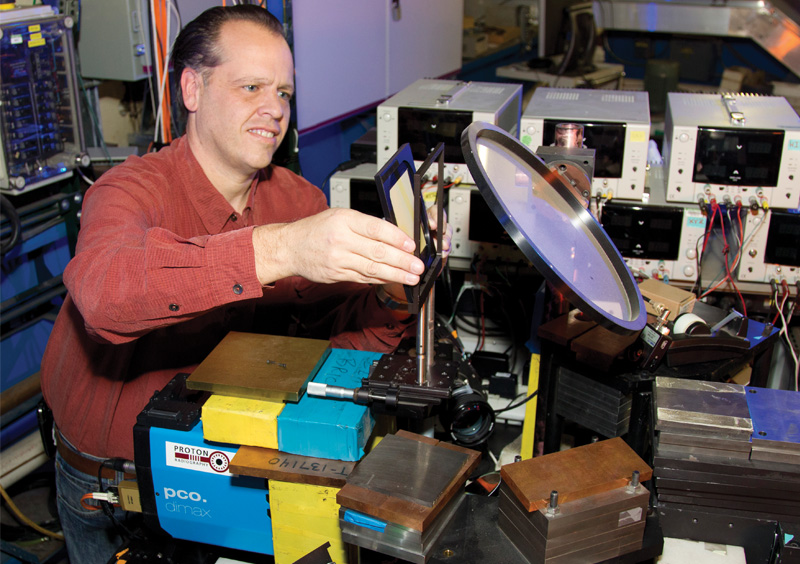Most people struggle to recall a phone number from memory now that we all have portable rolodexes in our pockets, but there are some whizzes at Los Alamos National Laboratory who make a hobby of memorizing numbers—the longer, the better. And Pi Day is a great opportunity to flex those numerical muscles.
March 14 is recognized as Pi Day, because the date on the calendar matches the 3.14 beginning of the irrational, infinite number that calculates the circumference of a circle. To mark this holy day for number nerds, 10 Labbies flexed their memory muscles by casually rattling off 3.14159, and some kept going for 20, 30, 50 decimal places—and onward—in a friendly recitation rivalry. Joshua Narlesky, who works in the Lab’s Materials Recovery and Recycle group, came out on top by listing 100 digits of pi.
How did Narlesky and his colleagues manage to internalize so many digits? Participants shared diverse, sometimes surprising strategies for becoming memorization mavens, from "chunking" and "bracketing" to using song lyrics, or as Rocky Ferran from the Lab’s Facility System Engineering Utilities and Infrastructure group noted: "I'm a nerd!"
Dyson Kennedy from the Theoretical division recalled the lyrics of a parody of the classic song "American Pie" to help him learn the numbers as a child.
"One of my older sister's math teachers had pulled it up on YouTube in class. This was before I came across pi in math," Kennedy said. "The song keeps going further, but it goes faster after what I know. You just got to find a way to get in the rhythm, but the song itself is funny."
Learning the numbers young also assisted Graham O'Brien Johnson of the Chemical Diagnostics and Engineering group, who said he was more advanced in math than his peers and memorized the pi banner hanging in his classroom while others tackled simpler concepts — perhaps a situation familiar to many children who grow up to work at the Lab.
"I had about 40 (digits) in 1998. I did it in that one big chunk and it just never left," he said. "I tried to get 10 more — rounded up to 50 for this (contest) 20 years later. ... I have a pattern, I have a sort of a metronome and I try and pick out little groups of things and memorize three digits at a time and just add a little bit more. You gotta keep coming back."
Baking up pi prodigies
With participants impressing their colleagues with double-digit recitations, it's remarkable to consider that at least two Labbies possess memorization talents far beyond even the best of the day’s competitors. Though neither joined the official contest, they each hold hundreds, even thousands, of digits in memory. So, what's the secret of these savants?
For Hayley Suitts, who works in the Intelligence and Space Research division, it all started with a friendly challenge overheard in high school.
"One day I was sitting there waiting for class to start, and I overheard some kid behind me rattle off 50 digits of pi," Suitts said. "I thought, 'I could beat that,' and by the end of the day, I could recite 80 digits. I managed to make it to 300 by graduation, and later won a college contest by writing out 864 digits."
Suitts acknowledges her talent is rooted partly in observation and partly in neurological luck — she experiences grapheme-color synesthesia, a condition that links colors to letters and numbers, enhancing her recall.
“Synesthesia is a neurological condition that is characterized by a crossing of the senses,” she explained. “In my case, it aids in memorization because, if I remember that a certain chunk of pi is ‘green,’ for instance, then I know that it contains a bunch of twos and fours.”
While Suitts’ memorization benefits from a colorful neurological advantage, Ari Essunfeld’s path to pi mastery began with childhood curiosity and evolved into disciplined, systematic practice. Essunfeld, who is now part of the ChemCam and SuperCam teams supporting NASA's Mars rovers — and who memorized digits of pi into the thousands — recalls becoming intrigued by numbers thanks to a classroom decoration.
"When I was in fifth grade, my math teacher had a poster on the wall with the first 75 digits of pi," Essunfeld said. "One day, I realized that if I closed my eyes, I could say the first few digits from memory. A few digits became a few more ... then I asked Mr. Adler to print the next 75 digits."
Essunfeld continued memorizing pi throughout his childhood and soon reached a well-known milestone among number enthusiasts: the "Feynman Point." Named for legendary physicist Richard Feynman, who worked on the Manhattan Project in Los Alamos, this unusual sequence occurs at the 763rd digit of pi, featuring six consecutive nines. Feynman joked that if he memorized pi, he would stop there, claiming facetiously that pi then simply repeats itself.
"That’s when it really took off, because all of a sudden my friends knew about it as this thing that I did, and so people started asking me what my plans were: How many digits do you have now? What are your plans for Pi Day? That kind of thing," Essunfeld said. He said at one time 14,000 digits of pi lived in his head, and he has videos on YouTube of him reciting massive blocks of pi, which take 30 minutes or longer. His goal is to break the North American record of 16,106.
Essunfeld refines his memorization technique through careful repetition and deliberate intervals of rest. He calls this approach "spaced repetition," a method proven effective in anchoring memories in the brain.
"The main idea is to practice new digits right away after learning them, then wait a day before practicing again, then wait two days, then four days, and so on," Essunfeld said. "This helps move the information from short-term memory to long-term memory. If I were to instead practice the same batch every day but never take breaks, I wouldn’t exercise the same 'muscles' that I need to recall that information from long-term memory. ... I could go months without thinking about the first 1,000 digits but still be able to rattle them off, because I’ve practiced recalling them after longer and longer periods of time."
While memorizing hundreds or thousands of digits of pi may sound daunting, Suitts insists it's not reserved for the gifted few. Rather, it’s a matter of motivation, interest and making the numbers personal.
"I think anyone can do this if the motivation is there,” she said. “We all have around 50 digits of personal information already memorized. Those of us grew up before cellphones still know our childhood friends' phone numbers by heart. We all know our social security numbers…and maybe even our bank account numbers. Memorizing random digits in pi isn't much different than memorizing personal information; it's just a matter of attaching meaning to the random digits until they feel familiar."
LA-UR-25-22411






